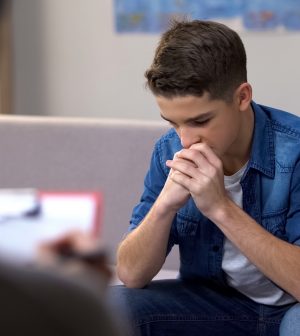- Navigating Your Midlife Crisis: Embracing New Possibilities
- City Raccoons Showing Signs of Domestication
- Mapping the Exposome: Science Broadens Focus to Environmental Disease Triggers
- One Week Less on Social Media Linked to Better Mental Health
- Your Brain Changes in Stages as You Age, Study Finds
- Some Suicide Victims Show No Typical Warning Signs, Study Finds
- ByHeart Formula Faces Lawsuits After Babies Sickened With Botulism
- Switch to Vegan Diet Could Cut Your Greenhouse Gas Emissions in Half
- Regular Bedtime Does Wonders for Blood Pressure
- Dining Alone Could Mean Worse Nutrition for Seniors
More Kids, Teens May Be Taking Multiple Psychiatric Meds

A study of mental health care in Maryland finds an increasing number of children and teens covered by Medicaid are taking multiple psychiatric meds.
This trend towards “polypharmacy” might be happening elsewhere, prior research suggests.
In the new study, Maryland kids ages 17 or younger experienced “a 4% increased odds of psychotropic polypharmacy per year from 2015 to 2020,” reported a team led by Yueh-Yi Chiang. She’s a graduate student at the University of Maryland School of Pharmacy.
Chiang’s group tracked prescription data for nearly 127,000 Medicaid enrollees under the age of 18 between 2015 and 2020. Those receiving multiple psychiatric drugs during that time rose from 4.2% in 2015 to 4.6% five years later.
“Individuals who were disabled or in foster care were significantly more likely than individuals with low income to receive three or more psychotropic classes overlapping for 90 days or more,” Chiang’s group noted.
Polypharmacy among kids in foster care rose from 10.8% in 2015 to 11.3% in 2020, the study found.
The reasons behind the steady increase in polypharmacy aren’t clear, although “factors such as complex medical conditions, early-life trauma and fragmented care may have contributed to these findings,” the team said.
Chiang’s group believes the findings “emphasize the importance of monitoring the use of psychotropic combinations, particularly among vulnerable populations, such as youths enrolled in Medicaid who have a disability or are in foster care.”
The study was published Feb. 16 in the journal JAMA Network Open.
As reported in the New York Times, numerous prior studies have suggested that similar trends are going on nationwide. For example, one paper found that in 2015, 40.7% of people in the United States between the ages of 2 and 24 who were getting an ADHD medication were also taking a second psychiatric drug.
More information
Find out more about the use of psychiatric meds by children at the National Alliance on Mental Illness.
SOURCE: JAMA Network Open, Feb. 16, 2024; New York Times
Source: HealthDay
Copyright © 2025 HealthDay. All rights reserved.










